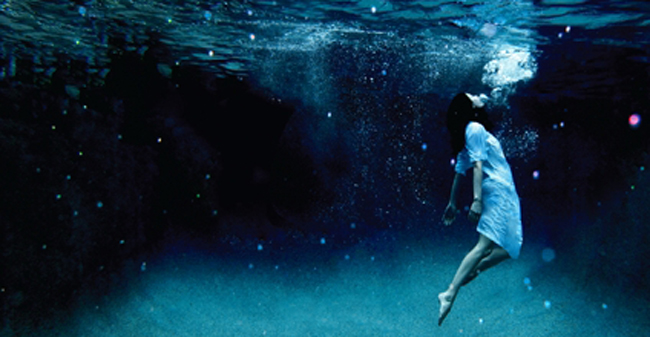Let’s take a break from looking at artwork.
Let’s look at some photos instead.
Most people like looking at photographs. Usually these are family photographs, sometimes in an album, sometimes projected on a screen with an old slide projector, sometimes stacks of prints and polaroids. Do you remember that? There’s that sense of nostalgia that automatically comes with perusing family photographs. The captured images of the past help us reconnect with times gone by. But even looking at other people’s photographs has a power, doesn’t it? These images on paper or projected on the wall represent lives that have been lived.
What does this have to do with science fiction or fantasy? And where does Neil Gaiman come in?
I’m getting to that.
Art is different. It’s held away. It’s on a wall, in a frame. There are layers between us and the art. Even if there isn’t a physical barrier, there is a tacit understanding that there is no touching allowed. In a museum an alarm might get tripped. Even if there isn’t an actual alarm there is the emotional alarm that comes when one’s grubby fingers come in contact with a priceless work of art. Alarmed fellow patrons are outraged which leads to alarmed security guards showing you off the premises.
Photos are different. You can hold a photograph. It is not the thing itself. It is a representation of another thing and, although there may not be another copy extant in the physical world (or the virtual) one is usually encouraged to hold it, to look closely at it. With art you step back. With photographs you lean in — you peer closely.
So when you are designing a book jacket, it is sometimes appropriate to use a photograph. Photographs are intimate. We step closer. We look deeply, trying to tease out its hidden secrets.
This would be all well and good for a book about everyday life, but what about science fiction? What about fantasy? What about the literature of ideas? What about the literature that sets about to cultivate a sense of wonder about the universe? How would a photograph — a grainy, intimate slice of everyday life — how does that serve to give the potential reader a sense of the wonders that wait between the covers?
This is why science fiction and fantasy covers usually go with cover art. The publisher’s marketing division relies on a cover artist to evoke the sense of wonder and to depict the strange and unique goings on that happen in the text. How else could you depict spaceships, galaxy spanning conflicts or portals between dimensions? What can a photograph tell the potential reader about the dragons, orcs and wizards that populate the pages of the novel?
You need a fantasy artist, right?
Not so fast. There’s photoshop now, right? I don’t need a painter. I can combine pictures and use Photoshop’s effects (that lens flare is a good effect, I’ll use that… again… and again… and again…) That’s good enough, right?
 Okay. I’ve used photoshop and photographs to create the covers for fantasy novels. It works if you know what you’re doing. It doesn’t look nearly as good as a painted cover in my opinion, but it works. Plus whoever is putting it together is an artist. Even if they’re not, they become one by choosing different photographs, by combining them in a way that says something about the story the image is representing.
Okay. I’ve used photoshop and photographs to create the covers for fantasy novels. It works if you know what you’re doing. It doesn’t look nearly as good as a painted cover in my opinion, but it works. Plus whoever is putting it together is an artist. Even if they’re not, they become one by choosing different photographs, by combining them in a way that says something about the story the image is representing.
There are people who think that all you have to do is slap some type overtop of a stock photograph and you have a cover. As a designer as well as an artist, I know that it’s not as simple as that. In creating a cover using a combination of photographs and type there are varying degrees of success. The results can be truly awful or, with a talented designer who knows what he or she is doing, sublime.
 One of the best book designers in the business is Chip Kidd. He is a superstar designer for the New York publishing house Alfred A. Knopf. He designed the iconic cover for Michael Crichton’s Jurassic Park. He also designed the cover for the book 1Q84 by Haruki Murakami. 1Q84 is about a woman in 1984 Tokyo who begins suspects that she has entered a parallel universe — an alternate reality.
One of the best book designers in the business is Chip Kidd. He is a superstar designer for the New York publishing house Alfred A. Knopf. He designed the iconic cover for Michael Crichton’s Jurassic Park. He also designed the cover for the book 1Q84 by Haruki Murakami. 1Q84 is about a woman in 1984 Tokyo who begins suspects that she has entered a parallel universe — an alternate reality.
Kidd chose to represent that purely with typography and one photograph. The book has a vellum slipcover which adds an extra layer to the images and perfectly captures the concept of the novel.
Now, Kidd is a master of that sort of thing and he must have known what he was doing because the book debuted at #2 on the New York Times bestseller list. That is as much a testament to Kidd’s packaging as it is to Murakami’s storytelling.
Neil Gaiman is a master storyteller. The British author’s books weave everyday life with fantasy and darkness. He has written comic books, most notably the Sandman title. He has also written for television (Neverwhere, Doctor Who) and movies (Mirrormask, Beowolf) and he has published several novels; American Gods, Anansi Boys and, most recently, The Ocean at the End of the Lane.
Here is the cover for that book. It’s a photograph.
Admittedly it is a striking photograph, taken underwater of a woman in a white dress rising to the surface of the water. That image combined with some simple typography has created a cover that is stunning and one that is getting a lot of positive buzz. I do not know which artists at Harper Collins designed the cover. I haven’t been able to see an advance copy and my emails to Harper Collins as yet remain unanswered. (If anyone knows, please let me know!)
As I said before, a photograph has with it a sense of intimacy and that, I think, is what publishers like about using them as opposed to art when it comes to book covers. A photograph draws you in and invites you to look in ways that artwork doesn’t. What is in a piece of art is what the artist wants you to see, but a photograph has a sense of captured time, a sense that the spinning chaos of life has been stopped for a moment and captured on a piece of paper.
That is an illusion, of course. These photographs have been vetted, processed and manipulated to death, almost as much as the photos you see on avery page of Cosmo or Harper’s Bazaar. Nevertheless, they have a power that has a different hold on the viewer than artwork does.
Me, I prefer artwork on my book covers. When I pick up a fantasy of science fiction novel I expect to see well rendered fantasy art helping to sell it. But there is value in photographic covers if done well.
What are your thoughts?













I really enjoyed the story of ‘Ocean’, but here in the UK, we’ve got a different cover for the book – got images of both covers on my blog https://ow.ly/n7Vv4 – but I much prefer the US cover (and generally prefer art as opposed to photos as covers)